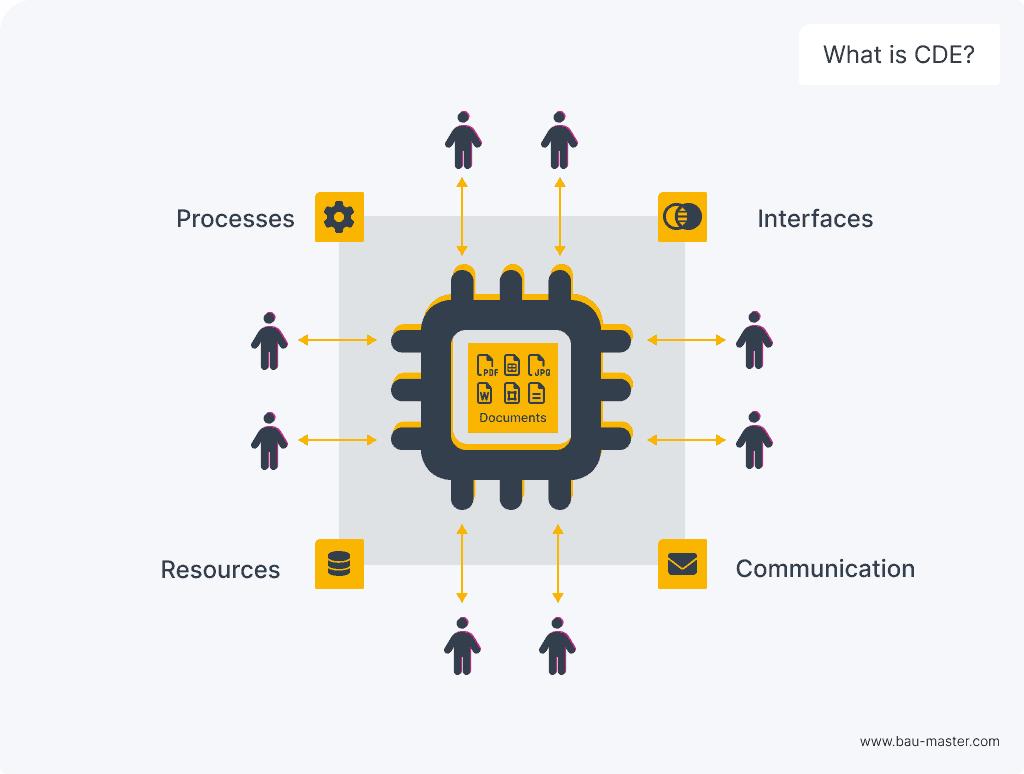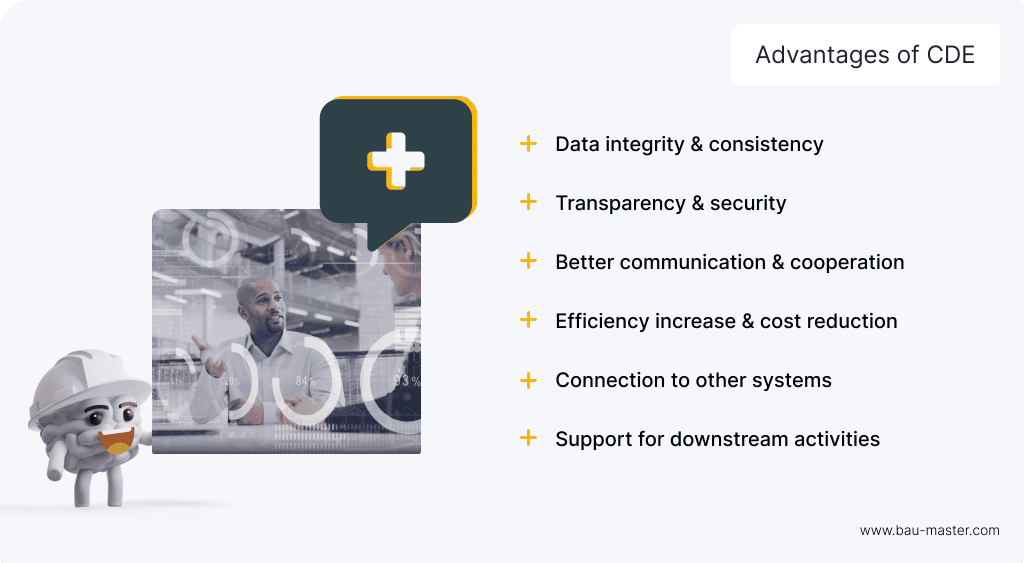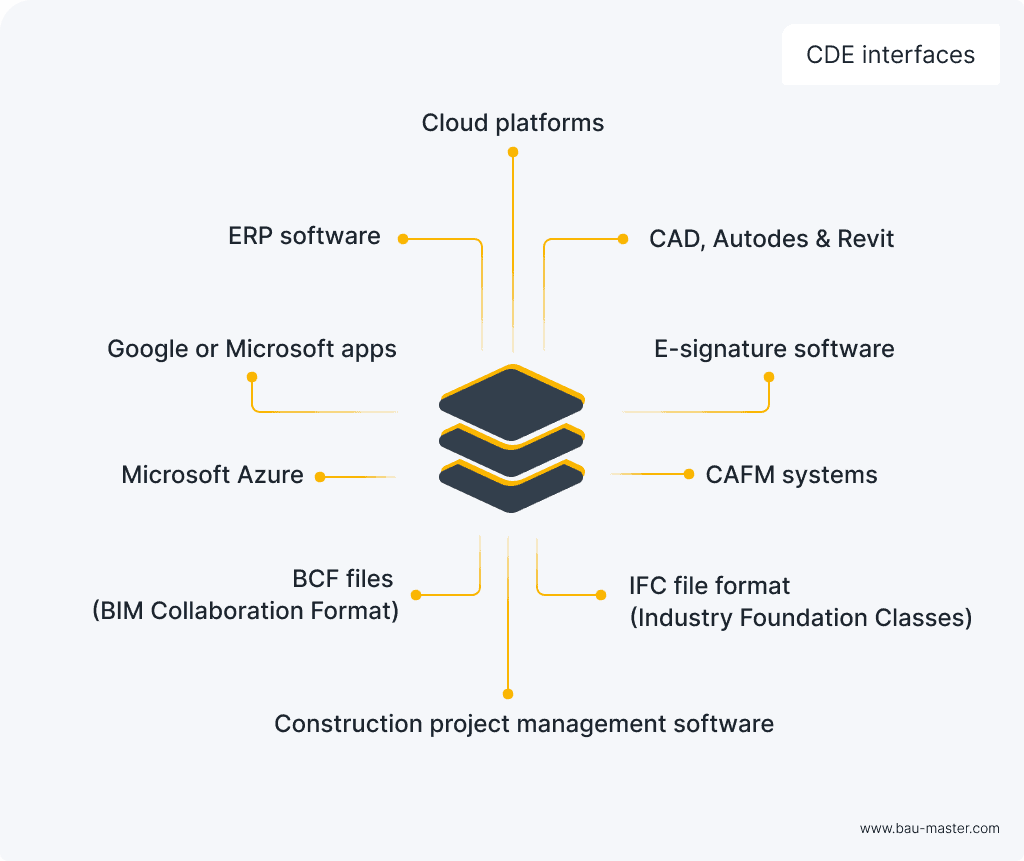Effective data management is essential to handle increasing project complexity and ensure seamless information exchange. This is where a Common Data Environment (CDE) comes into play: a centralised platform that allows all stakeholders to collect, manage, and share information.
But how exactly does such a system work, what are the benefits of a common data environment, and what does it take to implement one? You’ll find answers to all key questions here.
- What is a Common Data Environment (CDE)?
- Where are Common Data Environments used?
- Benefits of a Common Data Environment
- Risks of using a Common Data Environment
- How CDE and BIM work together
- Additional interfaces for a Common Data Environment
- Checklist – choosing the right CDE software for construction
- First step towards a CDE in construction: digitise your data
- The future of CDE and BIM
- FAQ: CDE in construction and other industries
CDE at a glance
What is a CDE?
A cloud-based platform that stores all project data in one place, ensuring a single source of truth for all stakeholders.
Where are Common Data Environments used?
E.g. in construction, real estate, and finance – anywhere project-based collaboration and data transparency are essential.
What are the key benefits?
Real-time access, secure storage, reduced errors, smoother communication, and integration with other tools.
What challenges exist?
Initial setup is effort-intensive, and success depends on consistent use and clear structure.
How does CDE support BIM?
The CDE powers BIM by centralising data, enabling faster updates, clash detection, and long-term data use.
What is a Common Data Environment (CDE)?
CDE stands for Common Data Environment. It refers to a central location where all project-related information converges. Storage is cloud-based, ensuring that all project participants can access it from anywhere. Access rights are managed through a permission system that determines who can view or modify specific data.
The more data the CDE contains, the better. This can include drawings, models, cost calculations, documents, lists, receipts, correspondence, meeting minutes, images, and much more. The CDE is often referred to as a single source of truth, as it forms the central repository of project information from which updates and changes are distributed.
CDE in construction
The shared project environment is used throughout all phases of a construction project – from planning and execution to the maintenance of the completed building. Therefore, the CDE also serves as a critical foundation for BIM (Building Information Modeling).

Where are Common Data Environments used?
Common Data Environments are primarily used in the construction, real estate, and financial sectors. In the construction industry, a CDE supports smooth and collaborative project execution. In real estate, it serves as a valuable tool for efficient asset management.
However, a shared data environment can be beneficial across all project-based work, regardless of industry. Many large industrial enterprises have already recognised the value of implementing a CDE solution to enhance collaboration and data transparency.
Benefits of a Common Data Environment
Using a CDE centralises all project-related details, creating a unified project space that offers multiple advantages:

Risks of using a Common Data Environment
To fully leverage the benefits of a CDE, certain challenges must be addressed. Without appropriate countermeasures, these issues may disrupt smooth project execution.
Initial setup and data migration
Setting up a shared data environment requires a considerable upfront effort. Sufficient time must be allocated to digitalise and consolidate all relevant data. Often, information is scattered across emails, personal computers, mobile devices, handwritten notes, or physical folders.
It is essential to avoid uploading outdated or duplicate information. If not properly controlled, this can reintroduce the very redundancies and errors the CDE is intended to eliminate.
How is a Common Data Environment populated?
1. Digitalisation of existing information: Before anything is uploaded, all relevant documents and data must be digitised. Depending on the project’s starting point, this process can take a significant amount of time and resources.
2. Data upload to the CDE: Once digitalised, data can be uploaded in bulk or individually. There are multiple methods for doing so – direct upload, cloud services like Google Drive or Dropbox, integration via authoring tools, or through other compatible software solutions.
3. Classification and metadata tagging: After upload, the data needs to be categorised and enriched with metadata for proper organisation and easy retrieval. This step can be performed manually, though increasingly it is supported by automated algorithms or artificial intelligence to improve accuracy and speed.
Structuring the project environment
The structure of a CDE must be carefully planned so that users can navigate it with ease. If the data is disorganised and workflows are undefined, team members will be reluctant to engage with the system. Therefore, an intuitive and well-structured environment is essential – one that is seen as an indispensable tool by the entire team.
To achieve this, a detailed benefit analysis should be carried out beforehand. This helps define systems and workflows tailored to the specific processes of the project and ensures that the CDE becomes a central and effective part of daily operations.
Ensuring consistent use
It is equally important to ensure that the CDE is used consistently by all project participants. A Common Data Environment can only function effectively if it remains the sole source of project information. If stakeholders revert to alternative methods or platforms, the advantages of a centralised data environment are quickly lost.
Maintaining strict adherence to the CDE as the primary workspace ensures complete data coverage and eliminates information gaps – both of which are essential for achieving reliable and efficient project outcomes.
Data security in a Common Data Environment
A shared data environment can significantly improve IT security – but only if the CDE software meets essential security standards:
If these safeguards are not in place, the Common Data Environment can become a major vulnerability – leaving the door open to cyberattacks and data breaches.
Summarized
To make the most of a Common Data Environment, ensure that the platform is properly set up and maintained, used consistently by all team members, and complies with essential security standards. When these elements are in place, the CDE provides the ideal foundation for a successful BIM project.
So how exactly does the connection between a Common Data Environment and Building Information Modeling (BIM) work? Let’s take a closer look.
How CDE and BIM work together
How do the virtual project space and Building Information Modeling (BIM) interact in practice? Essentially, one supports the other in driving better collaboration on construction sites.
The Common Data Environment provides the information backbone for the BIM model, standardising the setup and management of projects while acting as an interface for all information flows. While BIM can function without a CDE, coordination and data exchange become far more effective when both are combined.
This optimised process reduces both time and cost. Here are two real-world examples:
In addition, shared standards and technologies aim to further improve the synergy between CDE and BIM. Much like openBIM promotes open standards and file formats, the openCDE initiative by buildingSMART International focuses on enabling intelligent and seamless data exchange.
Ultimately, BIM also benefits from the supplemental data stored in the CDE. Even a digital twin of a building does not contain every project detail. This missing information is provided through the CDE, in combination with other tools such as ERP systems and project management platforms

Additional interfaces for a Common Data Environment
As previously mentioned, a digital data environment can be integrated with a wide range of systems and formats – BIM software is just one of many. Below are some common tools, platforms, and data formats that can be connected to a CDE:
By supporting such a diverse ecosystem, the Common Data Environment becomes a true integration hub – streamlining processes, reducing manual effort, and improving overall project transparency.

The Importance of Open Interfaces
We firmly believe that open exchange between systems is the future – enabling optimal collaboration among all project stakeholders.
BauMaster is committed to this vision: by building strategic partnerships, offering smart integrations, and promoting open interfaces, we are paving the way for a holistic workflow that seamlessly incorporates both CDE and BIM.
Checklist – choosing the right CDE software for construction
As any construction professional knows, successful execution requires the right tools. Here is a checklist of key criteria to consider when selecting CDE software:
Tip: Seek peer reviews, check references from other companies in the industry, and make use of free trials whenever possible. A pilot project can be particularly valuable for hands-on testing before making a final decision.
First step towards a CDE in construction: digitise your data
If you want to start preparing now, it’s worth assessing your current data landscape. How much information is still being recorded manually? Which documents still exist only in paper form?
A practical first step is to begin digitising all these materials and transition towards fully digital management and documentation processes. This will save you valuable working hours in the future. And once you’re ready to implement a CDE, you’ll have already completed the most time-consuming step.
Learn more about our digital construction software
The future of CDE and BIM
Anyone aiming to drive digital transformation in the construction industry must engage with both BIM and Common Data Environments. However, a “true” CDE – one that represents a project in its entirety – is still difficult to achieve.
The future of CDEs in construction lies in standardisation and openness. APIs are becoming increasingly important, and existing tools – such as BIM platforms and project management software – continue to evolve. This makes data-driven and interconnected construction workflows ever more accessible.
FAQ: CDE in construction and other industries
What is a Common Data Environment (CDE)?
A Common Data Environment is a centralised platform that consolidates all data related to a project. In construction, it often forms the basis for Building Information Modeling (BIM). The data is stored in the cloud, making it accessible to all stakeholders. A rights management system determines which users can view or edit specific information.
What is the difference between CDE and BIM?
CDE (Common Data Environment) is a central platform for data management and exchange, e.g. within construction projects. BIM (Building Information Modeling), on the other hand, is a methodology for creating and managing digital models of buildings across their lifecycle. A BIM model can use a CDE as its foundation.
Do BIM and CDE require additional personnel?
Yes, implementing BIM often requires specialised roles such as a BIM Manager to oversee the coordination of BIM processes, along with experts in BIM software. For managing a CDE, having a dedicated specialist can also be beneficial. Additionally, training existing team members is recommended to ensure effective use of both CDE and BIM systems.










